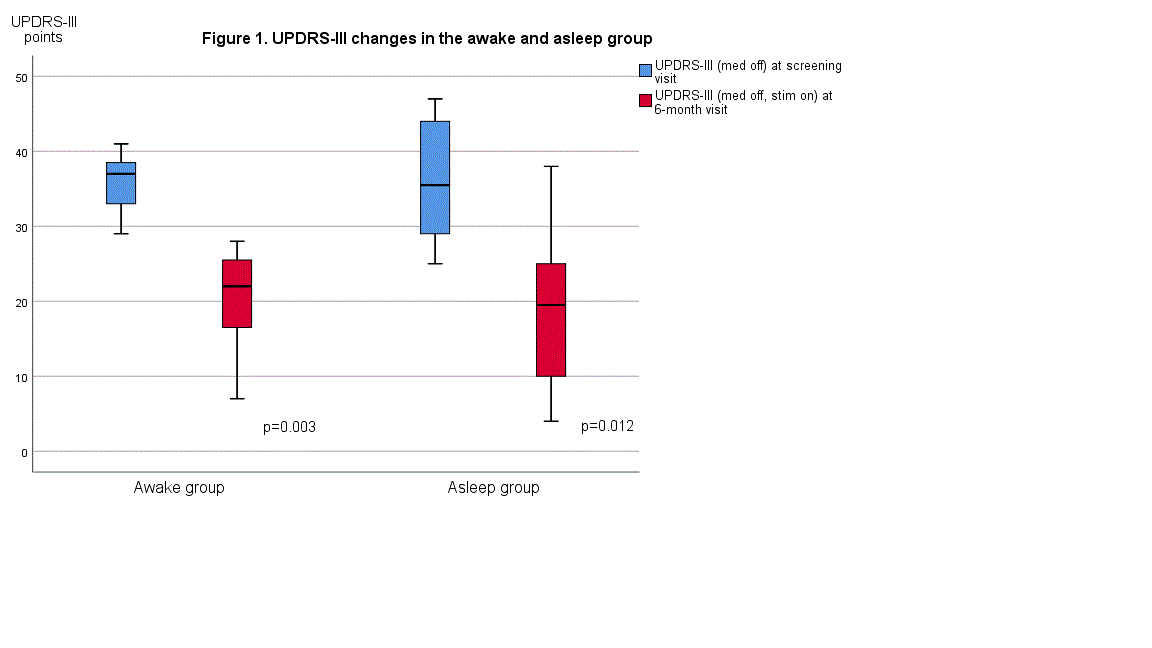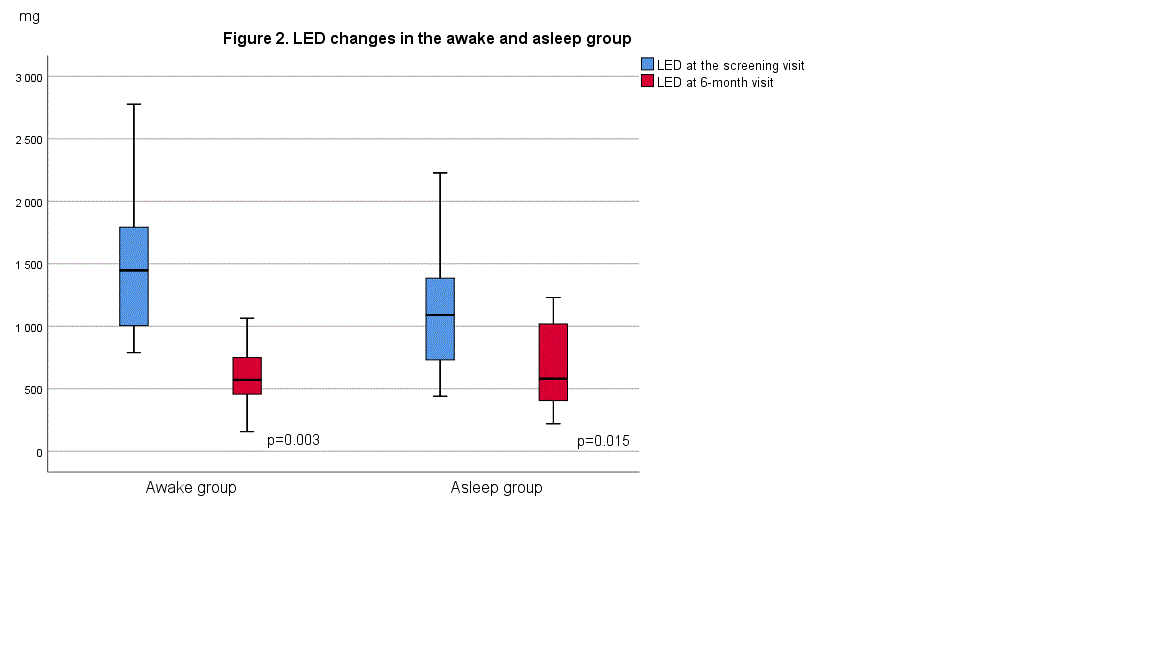Session Information
Date: Wednesday, September 25, 2019
Session Title: Surgical Therapy
Session Time: 1:15pm-2:45pm
Location: Les Muses Terrace, Level 3
Objective: To compare clinical outcome of patients with Parkinson’s disease (PD) treated with directional deep brain (dDBS) stimulation undergoing subthalamic deep brain stimulation operation (STN-DBS) under general anesthesia versus local anesthesia.
Background: Generally, DBS operation is performed under local anesthesia with intraoperative test stimulation. Recently, operation under general anesthesia has become more popular with good clinical outcomes [1-2]. Long-term follow-up studies using dDBS are sparse. We are conducting a comparative follow-up study on clinical outcome of dDBS in PD-patients who have undergone ‘asleep’ vs ‘awake’ operation. We present the preliminary results.
Method: 9 patients were implanted with directional DBS system (St Jude Medical, Abbott) under general anesthesia (‘asleep group’) and 11 patients under local anesthesia (‘awake group’). The clinical outcome was evaluated with UPDRS-III, AIMS, PDQ-39, MMSE between the screening visit and at 6-month postoperative programming session.
Results: There were no intraoperative adverse effects in the ‘awake’ or ‘asleep’ DBS operations. Two patients suffered from deep vein thrombosis (one from each group). UPDRS-III scores significantly reduced by median 41 % (IQR 8 – 87 % in asleep group and IQR 31 – 51 % in awake group), Figure 1. [figure1] LED reductions were significant, 42 % (IQR 22- 57 %) reduction in asleep and 57 % (IQR 48 – 70 %) in awake group, Figure 2. There were no significant between-group differences in LED or UPDRS-III changes (p=0.109 – 0.968). AIMS score decreased significantly in both groups [8 points (IQR 5 – 8 points) in awake group and 11 points (IQR 9 – 24 points) in asleep group] without between-group difference (p=0.126). MMSE and PDQ-39 remained unchanged. [figure2] In both groups, directional stimulation was preferred (10/11 patients in the awake group and 8/9 patients in the asleep group). Median stimulation parameters were (awake vs asleep group): 2.45 mA (IQR 2.2 – 3.2 mA) vs 2.6 mA (IQR 1.7 – 2.9 mA), 60 us and 130 Hz, impedances 1572 ohms (1156 – 1181 ohms) vs 1640 ohms (IQR 1206 – 2050 ohms) without between-group differences (p=0.211 – 0.659).
Conclusion: Our preliminary results showed that ‘awake’ vs ‘asleep’ dDBS seem to offer similar outcomes. Larger cohort study with a long-term follow-up comparing general vs local anesthesia and the clinical outcome is warranted.
References: 1. Brodsky MA et al. Clinical outcomes of asleep vs awake deep brain stimulation for Parkinson’s disease. Neurology 2017, 89; 1944-1950. DOI: 10.1212/WNL.0000000000004630 2. Chen T et al. Clinical outcomes following awake and asleep deep brain stimulation for Parkinson’s disease. JNS 2018. DOI: 10.3171/2017.8.JNS17883.
To cite this abstract in AMA style:
M. Koivu, J. Resendiz-Nieves, J. Eerola-Rautio, F. Scheperjans, R. Kivisaari, E. Pekkonen. Local anesthesia vs general anesthesia in STN-dDBS operation: a clinical comparison of the outcome of patients with advanced Parkinson’s disease [abstract]. Mov Disord. 2019; 34 (suppl 2). https://www.mdsabstracts.org/abstract/local-anesthesia-vs-general-anesthesia-in-stn-ddbs-operation-a-clinical-comparison-of-the-outcome-of-patients-with-advanced-parkinsons-disease/. Accessed December 28, 2025.« Back to 2019 International Congress
MDS Abstracts - https://www.mdsabstracts.org/abstract/local-anesthesia-vs-general-anesthesia-in-stn-ddbs-operation-a-clinical-comparison-of-the-outcome-of-patients-with-advanced-parkinsons-disease/


